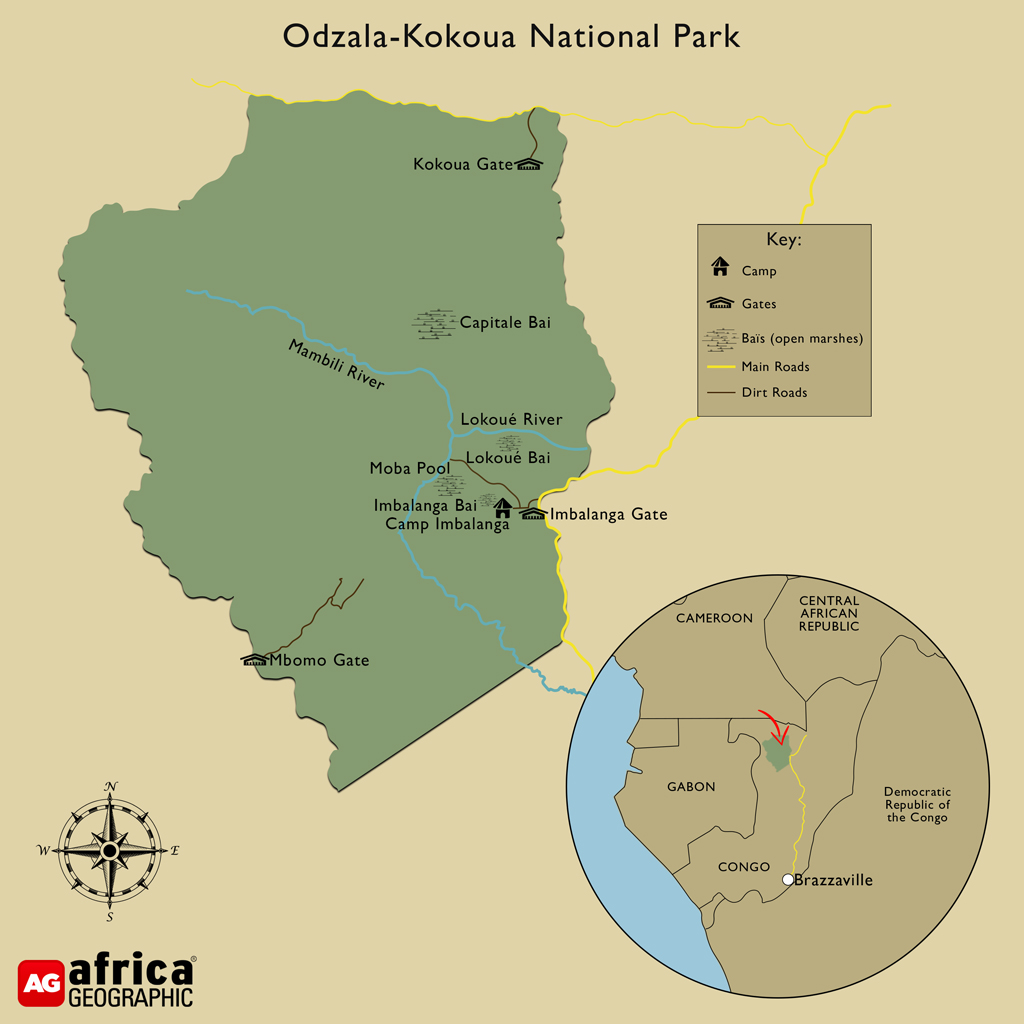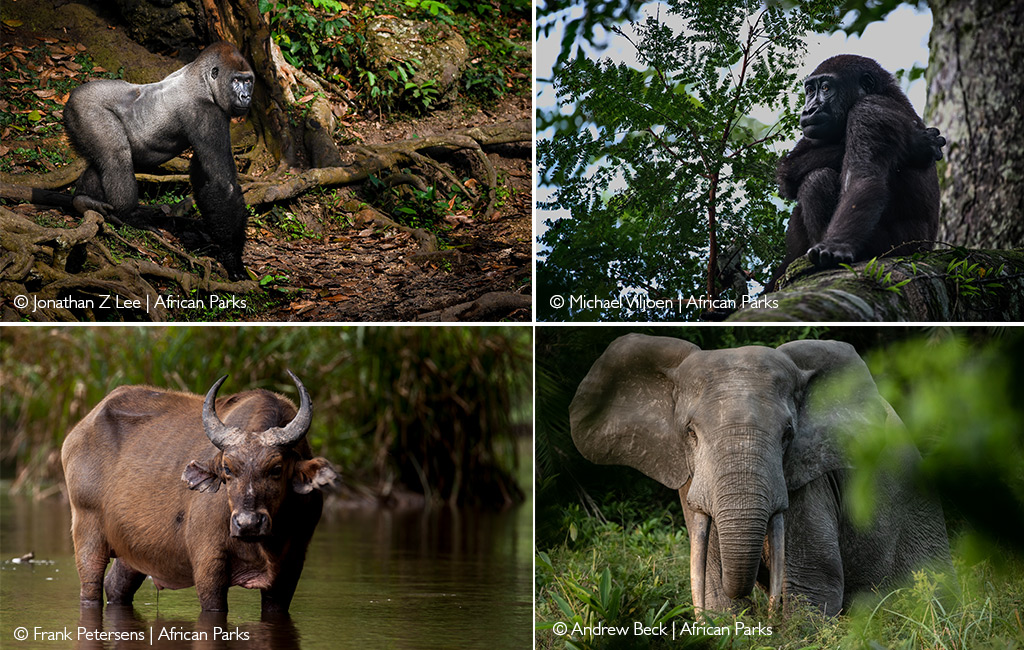
Biodiversity Bonanza

Along the Earth’s equator, vast, tropical rainforests spread across the continents like enormous green lungs, absorbing carbon dioxide from our atmosphere. These dark and often mysterious worlds are estimated to hold some 50% of the world’s terrestrial life forms – boasting higher biodiversity levels than any other habitat. They even play a role in controlling weather patterns. After the Amazon, Central Africa’s rainforest is the largest in the world. It includes the enormous section protected by Odzala-Kokoua National Park.
Odzala-Kokoua National Park
Odzala-Kokoua National Park or Parc National d’Odzala (Odzala from hereon) is one of Africa’s oldest national parks. The expansive 13,500km2 (1.35 million hectares) park is situated in the northern reaches of Congo-Brazzaville – not to be confused with the Democratic Republic of the Congo (DRC) to the east. As part of the much larger Congo Basin and an integral part of the TRIDOM Transfrontier forest, this magnificent reserve encompasses the famous forests, colourful swamps and vibrant swathes of savanna brimming with life.
The park has always been somewhat off the beaten track, but its fortunes turned when, in 2010, African Parks entered into a 25-year-long agreement with the ROC’s Ministry of Forest Economy, Sustainable Development and Environment. The park has been operating under African Parks management ever since. African Parks also runs the Sangha Trinational further north on the borders of the Central African Republic and Cameroon.
The complex and intricate community initiatives by African Parks recognise that the fortunes of the park and its people are inextricably linked. Their efforts even included an amnesty program, where poachers were allowed to surrender their weapons and train as park rangers. The result is a thriving ecosystem.


The baïs and surrounds
The park’s multitudinous habitats encompass everything from dense forests to open savannas, each with unique characteristics. The northwest’s dense forests open up into what is termed Marantaceae forest – defined by the flowering plants of the Marantaceae or arrowroot family that form a dense understory. These give way to gallery forests lining the floodplains of the more extensive waterways such as the Mambili and Lokoué Rivers – tributaries of the Congo River. The dry savannas are dotted with enormous termite mounds that create an other-worldly atmosphere.
However, the most distinctive characteristic of the Congo rainforest is the forest baïs – island clearings in the sea of trees. Here, marshy areas rich in minerals and salts attract a plethora of wildlife, from enormous flocks of green pigeons to western lowland gorillas and critically-endangered forest elephants.


‘The Forest Five’
Of the region’s megafauna, the forest elephants and western lowland gorillas are probably the park’s two main drawcards. A wildlife census conducted by African Parks in 2012 revealed that the park is home to some 9,600 forest elephants, and those that inhabit the more popular parts of Odzala have gradually become more accustomed to people.
Despite the devastating effects of the Ebola outbreak in the 2000s, Odzala is still a population stronghold of the western lowland gorilla and boasts the highest density on the continent. The gorilla numbers have gradually recovered, and there are now estimated to be around 25,000 gorillas in the park. The western lowland gorilla, a subspecies of the western gorilla (Gorilla gorilla), is the smallest of all subspecies. In Odzala, observing gorillas from elevated lookouts on the edge of baïs or visiting habituated family groups is particularly exciting because lowland gorillas are more arboreal than their mountain counterparts (such as those viewed in Rwanda or Uganda), and they are almost constantly on the move. The expert guides and trackers know the forest and the gorillas intimately. Wild chimpanzees are also in the forest, though none of the groups has been habituated yet.
Odzala is also one of the best places in Africa to see the bongo – a striking spiral-horned antelope. These shy animals are sometimes spotted on the forest baïs, along with sitatunga. The final two ‘Forest Five’ members – the forest buffalo and the giant forest hog are also drawn to the saline soils of the baïs.

Wildlife – the rest
Odzala-Kokoua is a naturalist’s paradise, bursting with almost incomprehensible biodiversity at every turn. Scientists estimate that the forest is home to some 4,500 species of plants, at least 100 mammal and over 440 bird species. You could search for dwarf crocodile, golden potto, Demidoff’s dwarf galago, Lord Derby’s flying squirrel or a host of other mysterious creatures. The open Marantaceae forest teems with insect life, and crocodiles, fishes, and frogs populate the swamps and rivers. View the Odzala mammal and birds lists here.
Expect to be fascinated by the variety of monkeys leaping through the canopy and intrigued by the possibility of spotting one of several small duiker species or even a serval or African golden cat. Though seldom seen, camera trap studies have revealed the presence of leopards, and spotted hyenas prowl the outskirts of the camps.
The antics of the red river hogs, with their hilariously tufted ears, are guaranteed to keep you entertained, while clouds of delicate butterflies add splashes of colour to the forest scene.
The birding in Odzala-Kokoua is excellent. The bird species tally of over 440 includes Hartlaub’s duck, Nkulengu rail, spot-breasted ibis, Congo serpent eagle, long-tailed hawk, vermiculated fishing owl, bare-cheeked trogon, white-crested hornbill, chocolate-backed kingfisher, lyre-tailed honeyguide, African piculet, grey parrot, African pitta, rufous-bellied helmetshrike and western bluebill.


Visit Odzala-Kokoua
With long-term stability in Congo-Brazzaville, tourism infrastructure has improved immeasurably. Odzala-Kokoua now offers tourists a safe way to experience one of Africa’s most breathtaking ecosystems. Even for the seasoned traveller, Odzala-Kokoua is a safari experience unlike any other.
A visit to Odzala-Kokoua is about adventure and discovery in one of Africa’s wildest spaces – it is not for the luxury-minded traveller looking for a laidback holiday. Most exploring is done from elevated lookouts on the edge of baïs, or on foot on elephant trails in the forest and wading through the small waterways or paddling along the Lokoué River in a kayak. The camps offer guided night walks to investigate the creatures that come out to play when the sun goes down for those entranced by the forest and eager to learn more.
Of course, taking a moment to soak in the atmosphere is always important. So, a day spent scrambling along forest paths in pursuit of gorillas can be rewarded by soaking tired feet in a crystal-clear stream. Or perhaps lounging on the lodge deck, serenaded by the strident cacophony of the rainforest.
The park has a few accommodation options, all designed to blend seamlessly into the scenery. Camp Imbalanga is a rustic, off-the-grid camp. Imbalanga baï is about 400m (3-minute walk) from the camp – offering an elevated lookout to watch western lowland gorillas, forest elephants and other wildlife. To find out more about this camp and make a booking, click here.
 DID YOU KNOW that African Parks offers safari camps (lodges and campsites) where 100% of tourism revenue goes to conservation and local communities? Find out more and book your African Parks safari.
DID YOU KNOW that African Parks offers safari camps (lodges and campsites) where 100% of tourism revenue goes to conservation and local communities? Find out more and book your African Parks safari.

Apart from the extraordinary wildlife, the magic of Odzala-Kokoua lies in its remote, undiscovered status. It is not unusual for a tourist to be one of only a handful exploring over one million hectares of pristine, Central African habitat. The verdant greens of the park’s swamps and primary forests are spectacular all year round, though there are officially two rainy seasons: from March to May and September to October. It is a rainforest on the equator, so wet weather is inevitable, but with sufficient preparation and sensible packing, this will not put a damper on the activities. Two pairs of comfortable shoes are a must, as is waterproofing for all camera gear, books, and binoculars.
Malaria is present and guests are advised to take suitable precautions and chat with a medical professional before travelling. A yellow fever vaccine is compulsory.
READ THIS travel diary from our CEO, who journeyed to Odzala-Kokoua NP

To comment on this story: Login (or sign up) to our app here - it's a troll-free safe place 🙂.![]()






